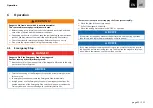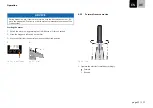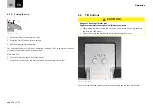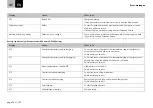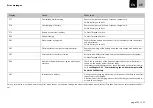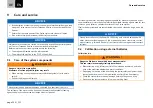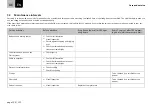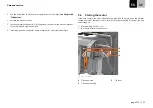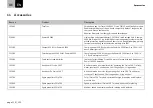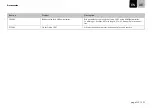
Care and service
9
Care and service
ADVICE
■
If the batteries or other components show signs of mechanical damage, stop
using the Cruise system. Contact Torqeedo Service or an authorised Service
Partner.
■
Ensure that the components of the Cruise system are clean at all times.
■
Do not store foreign objects near the battery components.
ADVICE
Maintenance tasks must be carried out exclusively by qualified specialist person-
nel. Contact Torqeedo Service or an authorised service partner.
Before maintenance or cleaning tasks, ensure the following:
■
The magnetic kill switch must be disconnected.
■
The main switch must be in the "OFF" or 0 position.
9.1 Care of the system components
WARNING!
Danger of injury from propeller!
Moderate or severe physical injuries may result.
■
When working on the propeller, always switch the system off at the main
switch.
■
Pull out the magnetic kill switch.
ADVICE
Have corrosion and paintwork damage corrected by a specialist if it occurs.
The surfaces of the motor can be cleaned with commercially available cleaning
agents; the plastic surfaces can be treated with vinyl cleaner.
For cleaning the motor, any cleaning agent suitable for plastic may be used as per
the manufacturer's instructions. Commercially available cleaning agents used for cars
achieve a good effect on the plastic surfaces of the Cruise system.
If cell or battery terminals are contaminated, they can be cleaned using a clean, dry
cloth.
ADVICE
Clean plastic surfaces of the Power 48 5000 using only a cloth dampened with
water. Never use cleaning agents. Cells or batteries must not come into contact
with solvents e.g. thinners, alcohol, oil, anti-rust products, or agents which attack
surfaces.
9.2 Calibration using external batteries
Calibration trip
WARNING!
Danger to life from a boat which is not manoeuvrable!
This can result in severe physical injuries or death.
■
Before starting a trip, inform yourself of the intended travel area, and take
note of the predicted weather and water conditions.
■
Depending on the size of the boat, keep the typical safety equipment ready
(anchor, paddles, means of communication, auxiliary drive if necessary).
■
Check the system for mechanical damage before setting out on a trip.
■
Do not use the system unless it is in proper working order.
page 104 / 121




